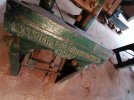Brassed Off
master brummie
During the building of the Beryllium Plant, the company at that time had its own builders and allied trades, the plumbers foreman paid a surprise visit to try and catch out his blokes having a skive. They were involved in fitting a shower unit, not your normal domestic type but one that was designed to douse a person with copious amounts of water to remove contamination. Unknown to the foreman the plumbers had finished the shower and were up above tidying up. The shower was designed to operate when the tray was stepped upon. With the call of “ where the devil are you” the tray was stepped upon!! Unbeknown to the foreman, the whole episode was being viewed by the plumbers that he was seeking. Making sure that no one had seen him the foreman who lived quite close to the factory jumped on his pushbike and pedalled off home to change. Word of this escapade quickly went around the factory, especially as the foreman in question was known throughout the site. Much amusement was enjoyed for a long time by all in the know.The Beryllium plant at Witton was specially built to produce this material. Witton also produced a number of other exotic materials at that time, over and above titanium, including hafnium, niobium, vanadium and, especially, zirconium. I think that beryllium manufacture had its own particular problems and this is why special facilities had to be created. It is highly toxic, as Mike mentioned, and therefore hazardous to produce. I have a vague recollection that, in addition, it was an activity which was surrounded by a fair amount of secrecy, perhaps for national security reasons.
There is only the briefest of mentions of this activity in the two Kynoch company histories. And they don't include any images. In fact, in view of the (possible) degree of secrecy it may be that none were ever published. My own potted history of Kynoch/IMI (see link below) reminds me that it probably started in around 1958 but I have no idea how long it lasted. I have a feeling that it didn't continue long into the 1960s, but I may be wrong. It would be interesting to hear if any other ex-IMI employees have any information about this specialised, and rather mysterious, chapter in the Company's history.
I hope you can make some progress, mandys19. Please let us know if you do.
Chris














